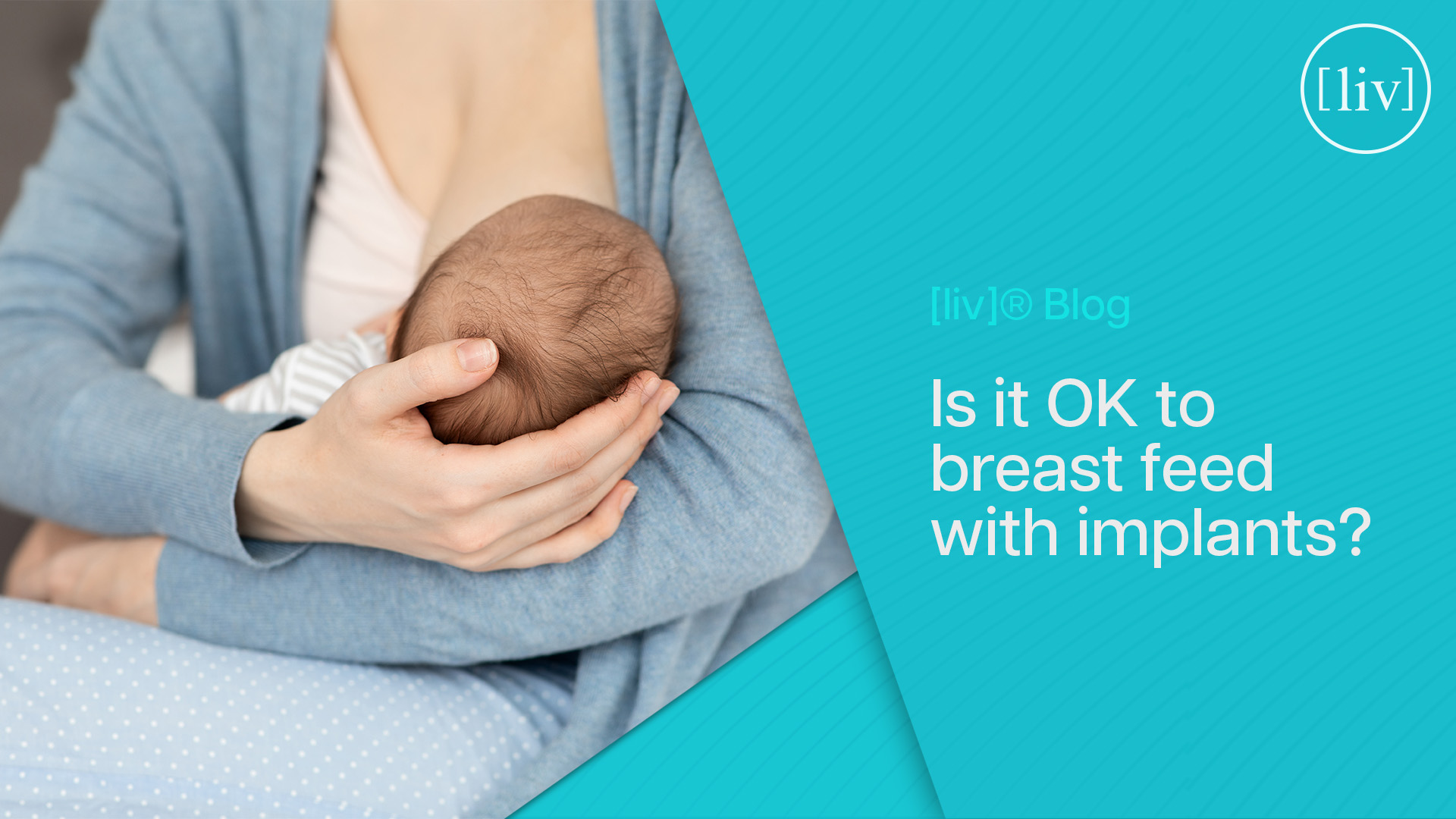Having in mind that breast augmentation procedure is one of the most popular plastic surgery procedures of all time, the question of breastfeeding with implants had to be raised at some point.
Breast implants may affect the amount of milk you’re producing, or, it can be vice versa – the breastfeeding can affect the shape and size of your implants.
Information regarding this topic is often times highly conflicted, and in this blog we try to demystify the subject and respond correctly – is it possible to breastfeed with implants, and if it is, what that entails, is it safe to breastfeed with implants, and everything else should you know about this subject – especially if you are a new mom, or a mom that plans on getting breast implants after nursing.
First and the most important question – can you breastfeed with implants?
The short answer is – yes, you can.
The long answer is – yes, you can, but it’s not that simple.
It is very much possible for mother with implants to breastfeed, but breast implants can also affect their capacity to produce a full milk supply necessary for breastfeeding. This is something that depends on a number of factors:
- Whether or not there is some scarring in the milk ducts
- The type of surgery that was involved
- The amount of damage caused to the nerved and breast tissue
- How much glandular tissue (tissue responsible for milk production) is present before and after the procedure.
Of course, breast implants are not the only factor that counts – the success if breastfeeding also depends on latching and positioning, as well as other factors.
Breast implants and breastfeeding – how do breasts implants affect breastfeeding?
As we already established – breast implants can temper with the milk supply, and here are the factors on which it depends.
The position of the incision
The location of the surgical incision determines where is the implant going to inserted, and the surgical technique in doing so determines how much damage is going to be sustained by nerves, milk glands, ducts and the blood supply.
- Impact on nerves – Stimulation of the 4th intercostal nerve (the main nerve that provides sensation to the nipple and areola) releases two breastfeeding hormones from the brain – oxytocin (responsible for milk release) and prolactin (responsible for milk production). If this nerve is damaged, than the whole process of producing and releasing milk is also affected, which ultimately makes it difficult for a mother to determine the feel of breastfeeding. To illustrate the point – if the incision is made to around the edge of areola, it is more likely to damage the 4th nerve that is critical to nipple sensitivity and breastfeeding.
- Impact on milk glands or ducts – Glandular tissue where the milk is produced is located within the breast, while ducts are the tubes that carry milk to the nipple. If anything cuts across and damages the said ducts or glands, this can interrupt the exit route for milk via the nipple, or the ability of glandular tissue to produce milk in its’ full capacity. However, a much greater possibility for something to be damaged is if you are doing a breast lift alongside breast augmentation.
Surgical techniques for inserting the implant
There are 5 most common surgical techniques to insert an implant – inframammary, axillary, periareolar, periumbilical and transabdominal.
- Inframammary technique – This is by far the most popular technique for breast augmentation. The incision is made under the breast and the implant is placed under the breast tissue or a muscle. The scar might not be visible, if the incision is in the crease, but also, this technique doesn’t impact the glandular tissue and the nerves, so it has the least impact on milk production.
- Axillary technique – This technique involves inserting the implant underneath the muscle, via the incision made near the armpit, usually done with saline type of implants. This is technique also leaves the glandular tissue and nerves intact, and scarring is too is practically invisible.
- Periareolar technique – This technique implies cutting around the nipple and areola, in order to insert the implant, and also, minimize scarring. However, this type of incision is the most associated with breastfeeding difficulties, making patients subject to troubles with breastfeeding and nipple stimulation.
- Periumbilical technique – This kind of incision involves inserting the implant via an incision in the tummy button, and bringing it into place above the breast muscle. This is solely done with saline implants, and it may cause damage to the breast tissue along the way, even though there aren’t any incisions that involve breast tissue and nerves.
- Transabdominal technique – This is one is usually used for smaller implants.
Size and position of the implant
When it comes to breast augmentation and breastfeeding issue, the size and position of the implant matter because they can affect the pressure within the breast.
Having in mind that the breast is composed of glandular tissue that is positioned above the a layer of muscle, if the implant happens to be placed between the glandular tissue and the muscle layer, it is more likely to add pressure on the ducts and glands, which than interferes with the milk flow and milk production.
That said, placing the implant beneath the muscle layer should have less impact on milk production, however, there hasn’t been done enough research to support the claim.
Occurence of scar tissue
Scar tissue can occur as a result of the surgery, which manifests as the firmness in the breast, distortion and pain, that can extend into milk ducts and affect the milk supply. If this continues, it can often lead to excessive engorgement and mastitis.
Increased sensitivity
Breastfeeding to some mothers can become extremely painful, if the breasts after surgery become very painful and sensitive even to a normal touch.
Conversely, other mothers might have a loss of feeling or numbness in the nipple, due to damaged nerves. This affects the reflex in charge of milk production, and makes it harder for mothers to know when the latch feels comfortable.
The lack of functional breast tissue
Abnormal breast development implies a cosmetic or a reconstructive surgery to enlarge a breast which means that – in the process, there could be an absence of a functional breast tissue, as an underlying factor.
This means that breastfeeding difficulties are likely linked to the absence of the functional tissue, rather than the implants themselves.
So – is it safe to breastfeed with breast implants?
There is far too many conflicting information regarding breastfeeding with implants.
During 1990’s, one support group has found that breastfeeding with implants can do some harm to children born to mothers with implants, however there is no sufficient evidence for that, mainly because silicon is chemically inactive and is unlikely to be absorbed in the gastrointestinal tract by a breastfed baby.
The bottom line
As it happens, many women who have breast implants, also have difficulties breastfeeding, mainly due to producing too small amounts of milk. If this is the case, you should definitely consult with your pediatrician or a lactation consultant about supplementing.
However, the bottom line is that not enough research has been done, nor evidence gathered to support the claim that breastfeeding with implants is in any way harmful to babies – until proven otherwise. Either way, it is important to address the factors we mentioned in this blog, and make an educated decision when it comes to undergoing breast augmentation procedure, especially if you plan on breastfeeding your children.


![Celebrate Mother's Day with Dr. Andrew Ress at [liv]](https://livplasticsurgery.com/hubfs/VALENTINES%20DAY%2025%20%281%29.png)
![Celebrate World Health Day with Dr. Andrew Ress at [liv] Plastic Surgery](https://livplasticsurgery.com/hubfs/VALENTINES%20DAY%2025.png)
![This Valentine’s Day, unveil your most stunning self at [liv] Plastic Surgery](https://livplasticsurgery.com/hubfs/Liv%20-%20Valentines%20Day%20Blog.png)
![New Year, New You: Embrace Change with Liposuction at [liv] Plastic Surgery](https://livplasticsurgery.com/hubfs/New%20Years%20Specials%20Blog.pdf.png)
